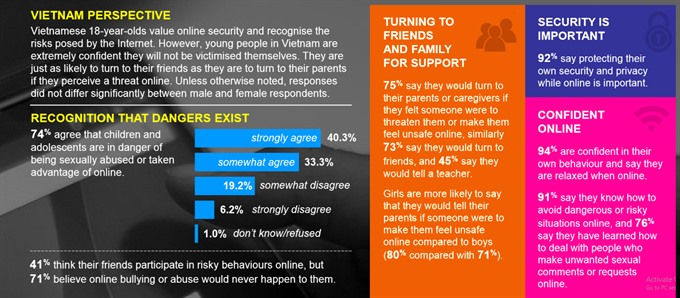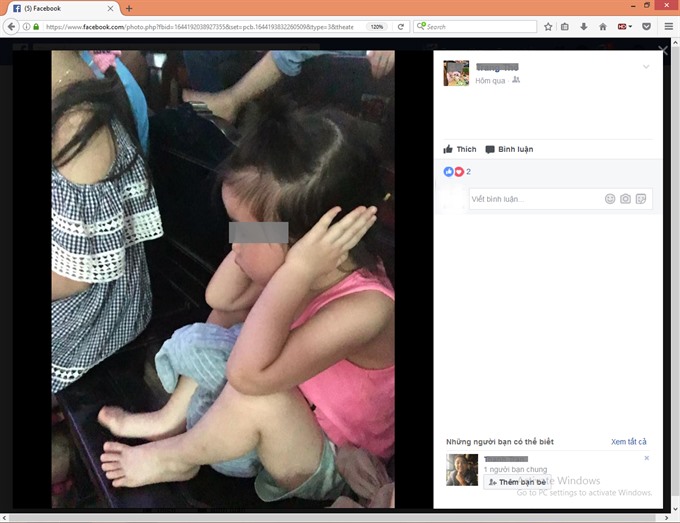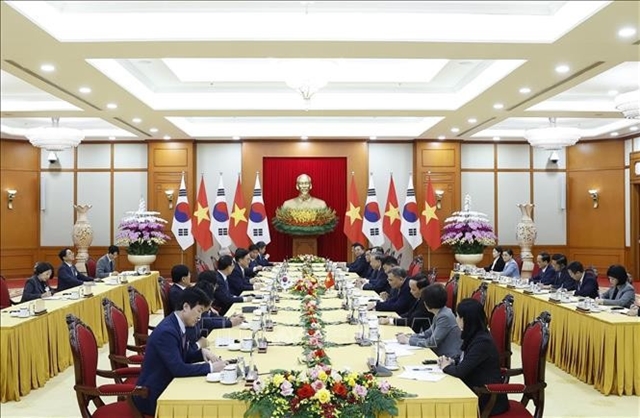 In the Spotlight
In the Spotlight

Posting photos and videos of children online may seem to be an innocuous pastime for many, but little do they realise the perils such digital footprints could cause for their children.
 |
Mai Khuyên
HÀ NỘI — Posting photos and videos of children online may seem to be an innocuous pastime for many, but little do they realise the perils such digital footprints could cause for their children.
While an internet-savvy user may know the ramifications of posting personal details, Hoàng Phương Thanh and Trần Trung Dũng, a couple from Hà Nội’s Hoàng Mai District, had to learn the hard way, suffering emotional distress, panic and regret.
After six years of marriage, and the pain of miscarriage, Hương and Dũng managed to have their only daughter, who is now 13. From their daughter’s first days, the ecstatic couple would click photographs of the child and post them online, including on social networking sites like Facebook, Instagram and Twitter. They even created an account for her and filled it with snaps — from her first steps as a toddler to her days at school.
This continued for a long time, until one day, a relative informed them that their daughter’s image had been posted on a child porn website, along with her personal information, including birth date, home and school address.
Initially, the parents were incredulous, but rushed to check it for themselves. Disbelief gave way to shock when they checked the website and found a picture of their daughter wearing a bikini at the beach. The image had been taken during a family trip to Nha Trang Bay and had been posted on social media.
The horrific revelation was followed by frenetic visits to the police station, courts and most importantly, hours of deleting all pictures posted online, as well as canceling all accounts.
The case of Hương and Dũng is just one among many millions of others, in which couples or individuals have inadvertently facilitated the use of children’s photographs on child pornography websites, without adequate knowledge about internet safety.
According to Hương, although they realised the danger of sharing images rather late, it is a lesson for other parents who randomly post pictures of their children on the global network.
Hương has appealed to both parents and children to consult experts before posting any images online.
We clearly cannot live without the internet, as it has revolutionised our lives. Information and communication technologies are transforming our lives in so many ways, most of them for the better.
However, while many opportunities for learning, recreation, playing and socialisation are available because of new technologies, unfortunately, there is a dark side to such activity that can pose a risk to children’s safety.
 |
| Nguyễn Ngọc Anh, child protection specialist, United Nations Children’s Fund |
The same tools that have helped revolutionise people’s access to information, such as social networking sites, can also facilitate the abuse and exploitation of children, Nguyễn Ngọc Anh, child protection specialist from the United Nations Children’s Fund, said.
Anh discussed some of the dangers present online. Online abuse is a type of abuse that happens in cyberspace, such as through social networking sites, chat rooms, while playing online games or using mobile phones, Anh said.
Children and young people might experience cyber-bullying, grooming, sexual abuse, sexual exploitation or emotional abuse, he told Việt Nam News.
According to Anh, although millions of children and young people are benefiting from social and educational opportunities that ICT (Information and Communication Technology) has opened up, they might also be exposed to materials for abuse, including violence, pornography and intentional or unintentional insults, Anh said.
In Việt Nam, children are threatened by bullying and harassment from peers, which is cyber-bullying. Many on their own endanger themselves by sharing personal information, including sexual images and videos, also called ‘sexting’, and establishing relationships with people online, unaware of the risks.
Sexual images of Vietnamese children can be purchased on DVD, although the majority of customers prefer anonymity and purchase child pornography via the internet and mobile phone, Anh said.
Perpetrators of child pornography even steal photographs from the internet by illegally penetrating personal accounts, and sharing and exchanging the materials available there through online networks.
Incidents are often reported when children establish relationships online, followed by meetings in person with subsequent sexual abuse and trafficking, Anh added.
“The information we put online leaves ‘footprints’ that help identify or trace young people easily. Once the information is online, it is hard to remove; it can be copied, cached and may be around forever,” Anh said.
The explosion of digital technology has had an undeniable link to the escalation in commercial sexual exploitation of children, as offenders use the internet and mobile phones to lure children, transmit sexual images of children and blackmail them into exploitative situations, whilst assured of anonymity and hidden pathways for direct contact between the offenders and victims.
 |
| Professor Phạm Quang Minh, Chairman of the Scientific Research Council of the Việt Nam Programme for Internet and Society |
According to Professor Phạm Quang Minh, Chairman of the Scientific Research Council of the Việt Nam Programme for Internet and Society (VPIS), whether posting images of children on the internet could present a danger or not depends on the internet users’ knowledge of ICT safety.
After over 20 years of development in Việt Nam, with the traditional culture of community strongly prevailing over privacy, the internet has impacted the lives of all individuals and society as a whole.
Statistics from the VIPS revealed that the country has more than 35 million social media users nation-wide, equal to nearly 40 per cent of the population, with an average of two hours and 18 minutes usage per day.
With such large coverage and high number of users, the internet is obviously fertile ground for those looking to exploit people, particularly children, who are one of the most vulnerable groups in society, Minh said.
Vulnerable group
In Việt Nam or any other country in the world, children are more vulnerable to online abuse and exploitation, as they themselves are not fully equipped to understand the potential risks, and are not always aware of the potential consequences of online activity.
Not only parents but also individuals, companies or organisations that do not have adequate knowledge of internet safety, could expose children to abuse by posting images or video clips online, Minh said.
“Such photos may look harmless, as they present a picture of happiness or joy, but for strangers, or ‘internet devils’, such as child sexual abusers, traffickers or even kidnappers, the internet is a profitable medium to exploit children. The child’s image may be used for unscrupulous purposes,” the internet and society expert said.
To deal with or limit the dangers present online for internet users, particularly children, the roles of ICT providers, network administration and internet users themselves should be taken into account in any ICT safety programme or campaign.
ICT providers should be fully responsible for their products to ensure they are not causing any harm to their customers, while network administrators should levy strict penalties on those users who violate internet rules by posting insulting comments and photographs, which may be emotionally offensive or sexually abusive, Minh said.
Internet users themselves should not neglect to protect themselves from being abused directly or indirectly. Any abusive post or comment should be flagged immediately, the expert added.
Concurring with Minh, Tô Thị Hương Giang, senior Social Work Practitioner at Blue Dragon Children’s Foundation, warned that one should be extremely cautious when putting up children’s images on the internet, including organisations raising funds for their operations, or companies advertising products or services.
As part of an organisation specialising in protection and charity work for Vietnamese children across the country, Giang, while describing Blue Dragon’s approach, said a child’s picture on an organisation’s website should reflect the true life of the child, so that it would not harm their life in the present or in the future.
“The organisation should ask for permission from the child and his/her parents or guardians. The permission should be taken in writing with signatures from all sides. The photographs or videos of the child should undergo review procedures, involving the child themselves, his/her parents or guardians, lawyers, the website administrator and the officials of the organisation, before they are posted on the internet,” Giang said.
The official warned that if organisations are not careful while posting images or videos of children on the internet, the children may face both physical and emotional pain.
For example, Giang said, a charity organisation might violate the law on protection of children if it took advantage of children’s images to raise funds, especially, if the children face with difficult circumstances, such as infection with HIV, have been abandoned or are a sexual harassment victim.
Although the image may be truthful to their real-life situation at that time and may easily stir the donors’ compassion, it might harm their future, and thus, intentionally or unintentionally, it can lead to hurtful and unhappy conditions, Giang warned.
 |
Legal advocating
Việt Nam has demonstrated its commitment to online protection of children through its ratification of relevant international children’s rights instruments and the recent passage of the 2016 Law on Children, which includes a whole chapter on child protection in general and an article dedicated to child protection online.
The specific provision in Decree No 56/2017/NĐ-CP2017, signed in May by Prime Minister Nguyễn Xuân Phúc and issued recently, has strengthened the country’s commitment to safeguarding children and respecting children’s rights, including the right to privacy, enshrined in Article 16 of the United Nations Convention on the Rights of the Child, in addition to responding to the potential risks of online abuse and exploitation, Anh said.
 |
| Lawyer Đỗ Thị Thao Hà, member of the Hà Nội Bar Association |
Lawyer Đỗ Thị Thao Hà, member of the Hà Nội Bar Association said with the rapid rise of the internet, posting photographs or video clips of children on social media could lead to unpredictable risks for children, so strict laws are needed to cope with the issue.
Commenting on the newly issued decree 56, she pointed out that although it contained eight provisions from Article 49 to Article 56 assigning a legal role and responsibility to individuals and organisations for the protection of children online, the decree had not defined specific guidelines for punishing and imposing sanctions on violators, as well as clarifying the levels of violations.
The handling of violations or prosecution of criminals in connection with online crimes against children is not possible, as there is no adequate or relevant regulations on violations, she said.
To guarantee the legitimate rights and interests of the child, Hà said authorities should concretise all regulations concerning protection of children in the online environment.
The decree is regarded as a foundation for the handling of violations related to children’s protection online, so it should also be considered a starting point for the implementation of regulations relating to privacy of children, as cited in the 2016 Law on Children, Hà said.
Minh and Giang both expressed concern about the performance of the decree, noting that there was a gap between the law and its implementation.
To make the decree more practical in reality, particularly in protecting children from online dangers, there should be close cooperation between authorities, organisations, schools and families, the experts suggested.
Children should be protected from abuse and insults. To ensure this, programmes and campaigns should focus on creating social awareness about online dangers and educating children about staying safe online, the experts have suggested. — VNS




